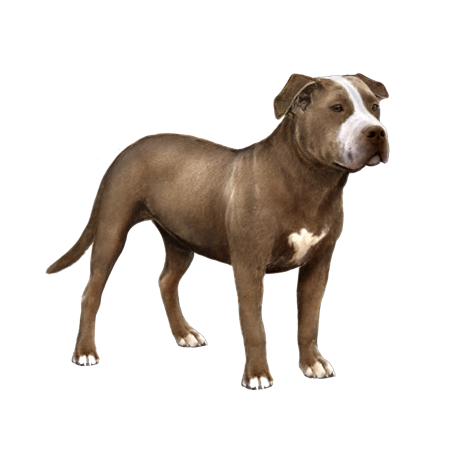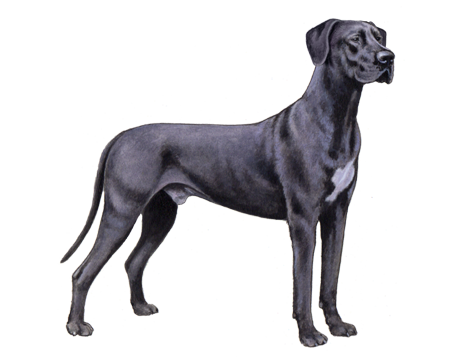
Bullmastiff
The Bullmastiff is a good-natured, calm, and affectionate breed. Devoted to their families and typically docile, Bullmastiffs are very protective and alert. They make excellent guards thanks to their intelligence and trustworthiness.
Interested in discovering if your dog is a Bullmastiff?
Check out Wisdom Panel's DNA tests.

Bullmastiff Traits
General Appearance
Bullmastiffs are large, bulky, and muscular dogs that are confident, watchful, and powerful. Dark eyes, V-shaped ears, wide nostrils, and a broad, deep muzzle complement the Bullmastiff’s sizable square head.
Coat and Coloring
The Bullmastiff’s coat is short, straight, and coarse in texture, lying flat to its body. Fawn, red, red-fawn, and brindle are typical colorings.
Distinctive Physical Traits
What makes the Bullmastiff stand out is its robust and symmetrical build, a full and deep chest, strong legs, and muscular, sloping shoulders. When moving about, these dogs radiate a sense of power and purpose.
Bullmastiff Temperament
Bullmastiffs are fearless when working, yet docile while at home. They are wary of their surroundings and always alert. And though they have a lot of power, they make for sweet family pups.
Because of their background as guard dogs, Bullmastiffs may be aloof around people or dogs they don’t know. But socialization can help with this. Though these well-mannered, loyal companions are generally good with children, they can be overly protective when strangers are nearby. That being said, Bullmastiffs aren’t easily provoked.


Bullmastiff History
The history of the Bullmastiff dates back to the mid-19th century. English estate owners needed a guard dog that would protect their properties from poachers. So, breeders began crossing English Bulldogs with Mastiffs.
The breeders sought to develop a powerful breed capable of knocking down an intruder and holding that intruder to the ground until the master arrived. The new breed was so good at this job, people often referred to it as the gamekeeper’s night dog.
Bullmastiffs generally come in fawn, red, red-fawn, and brindle. When the dogs were used primarily for hunting, the darker colors were preferred. But now that Bullmastiffs are often used as family pets, the fawn color is more popular. The American Kennel Club officially recognized the Bullmastiff as a breed in 1933.
Bullmastiff Care
Nutrition
You should feed large-breed puppy food to your Bullmastiff puppy. This will help ensure that their growth is slow and steady.
For puppies, serving several small daily meals is best. But for adults, two meals per day is better. Digesting too much food at each meal can be problematic because Bullmastiffs are at risk for Bloat. For the same reason, experts warn against strenuous activity directly before and after eating.
Particularly as puppies, Bullmastiffs need to stay at a healthy weight. They grow very quickly, so obesity can be especially harmful.
Grooming
You can expect your Bullmastiff to shed seasonally. Frequent grooming will ensure that this shedding remains under control. Bathe your dog only as needed, but take care to keep your dog’s deep facial wrinkles clean and dry.
Sometimes, dry or oily skin and coat related to diet or allergies can be an issue. Also, keep in mind that Bullmastiffs are droolers.
Exercise
Moderate daily exercise will keep your Bullmastiff happy and healthy. Though some prefer to sit on the couch, many dogs of this breed enjoy brisk walks, outdoor play, and other activities. They do not, however, make good running partners.
To prevent health problems, do not exercise your Bullmastiff puppy excessively—especially during periods of rapid growth.
Training
Bullmastiffs training should be firm and gentle and begin at a young age—while the puppy is still small enough to control. Experts recommend enrolling in puppy classes to introduce your Bullmastiff to other dogs early.
Bear in mind that Bullmastiffs are stubborn and strong-willed, especially as puppies. But they respond well to a reward-based approach to training. Bullmastiffs are pros at agility and obedience exercises, and they possess commendable scent tracking skills.

Bullmastiff Genetic Health Conditions
-
Canine Multifocal Retinopathy 1
Canine Multifocal Retinopathy 1 (CMR1) is an eye disorder that can cause retinal decay which may impact vision, but very rarely results in blindness.
-
Dominant Progressive Retinal Atrophy
Dominant Progressive Retinal Atrophy (DPRA) is an eye disease resulting in vision loss and eventual blindness.
-
Hereditary Calcium Oxalate Urolithiasis, Type 1
Hereditary Calcium Oxalate Urolithiasis, Type 1 (CaOx1) is a genetic disorder that greatly increases the risk for urinary stones composed of calcium oxalate to form within the kidneys or bladder.
Knowing if your Bullmastiff is a carrier or at-risk for these conditions can help you and your veterinarian plan for your pup’s lifelong care. With Wisdom Panel™ Premium, you can get results for over 200 genetic health tests.
Breed Group
Guard
Dogs of the Guard Group were bred to guard people and property. They are often quick to learn and these intelligent, capable animals make solid companions.
Resources
https://www.akc.org/dog-breeds/bullmastiff/
https://vcahospitals.com/know-your-pet/dog-breeds/bullmastiff
Reviewed July 26, 2020 by Cindy Elston, DVM, MPH























